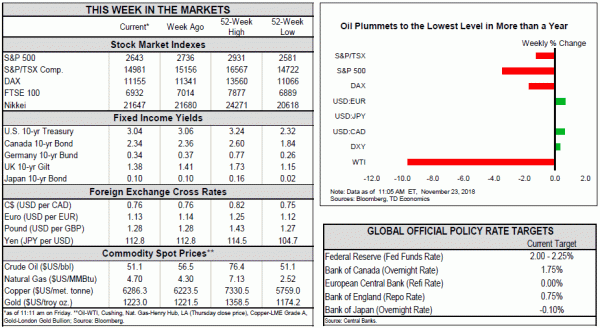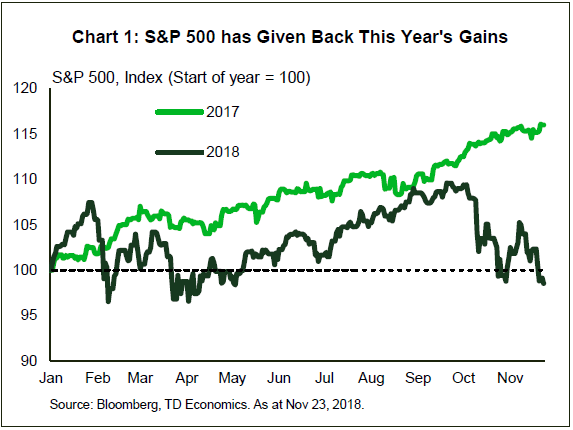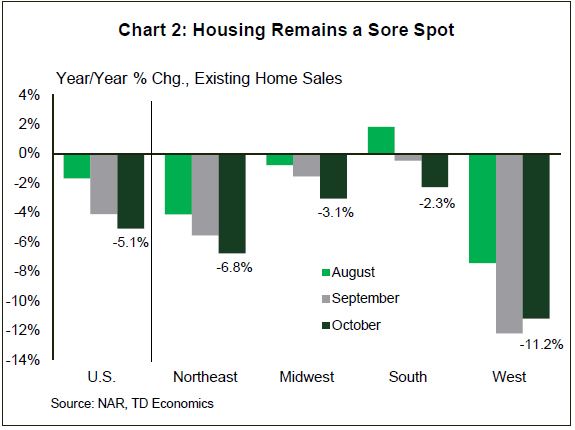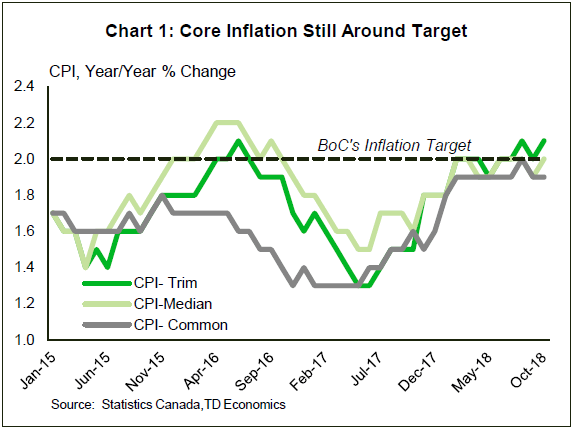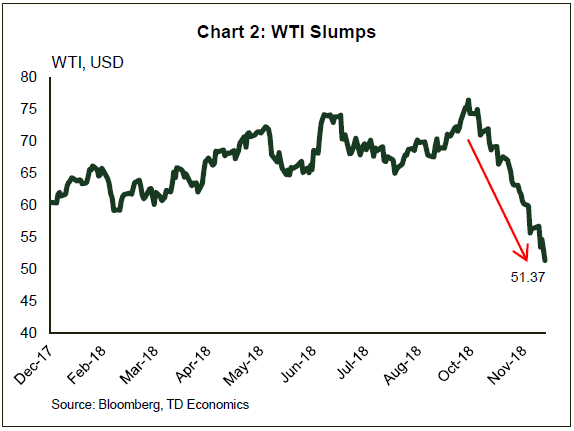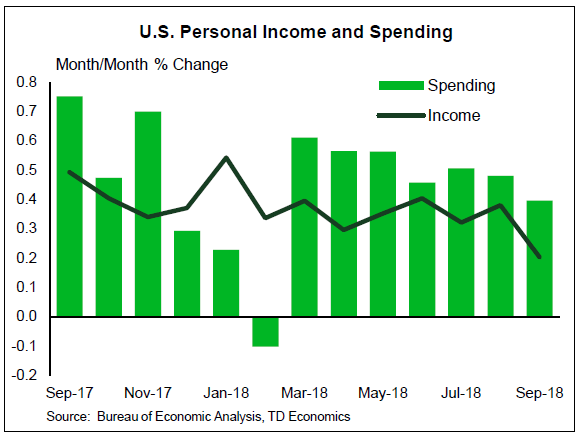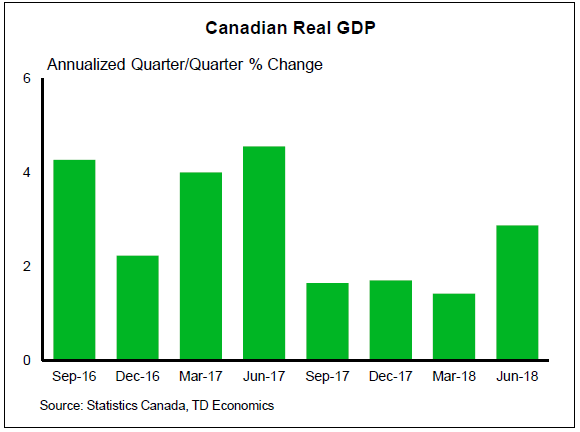U.S. Highlights
- Equity market volatility persisted this week as the main indexes were dragged down by tech and energy stocks. The latter resumed their slide as oil prices fell to their lowest levels in more than a year.
- Housing data was mildly positive, but continued to drive in the point that the sector remains a sore spot. Both existing home sales and housing starts rose around 1.5% month on month in October. But, sales are still down some 5% year on year, weighing on builder confidence.
- Presidents Trump and Xi will meet at the G20 summit next week in Buenos Aires. Any conciliation would be a plus for financial markets. Here’s hoping that the atmosphere and outcome are as pleasant as the host city’s name.
Canadian Highlights
- This was a week heavy on data, with wholesale trade coming in below expectations, retail sales surprising to the upside, and headline inflation posting a broad-based pickup.
- The main event, however, was in Ottawa, with the release of the federal government’s fall fiscal update, which focused on measures to address Canadian business competitiveness.
- Oil hit a 1-year low as of writing, fueling worries about price levels going forward and the expected impacts on the Canadian economy.
U.S. – Despite Sour Week, There Is Still Plenty to Be Thankful For
What a difference a year makes. Investors had much to be thankful for at last year’s Thanksgiving, with equity indexes experiencing double-digit gains from the start of the year. This year, the atmosphere is a lot less bubbly. The S&P has given back all of this year’s gains and some (Chart 1). Volatility persisted this week as the main indices were dragged down by tech and energy stocks. The latter resumed their slide as oil prices fell to their lowest levels in more than a year. Shifting headlines on Brexit and a softening of manufacturing PMIs in Europe did little to help broad market sentiment. Investors tilted funds toward safer assets such as Treasuries, contributing to a slight pullback in yields.
Despite the carnage in equity markets, there is still plenty to be thankful for. The U.S. economy remains the growth-leader among the G7 and appears likely to retain its lead over the next year. Its labor market echoes this strength, with more job openings than there are unemployed Americans. This backdrop has allowed the Fed to raise interest rates at a faster pace than its peers and also gives it the flexibility to respond to any future hiccups in growth.
The rise in rates, however, has had an impact on typically interest-rate sensitive sectors of the economy, most notably housing. Despite some improvement in housing data this week, the sector remains a sore spot. Both existing home sales and housing starts rose around 1.5% month on month in October, propped up by the volatile multifamily segment. The uptick in resales was encouraging, since it marked the first gain in six months. But, sales are still down some 5% from a year ago (Chart 2). Current conditions are providing little comfort for builders, whose confidence took a plunge this month.
With interest rates rising, resale activity is likely to remain soft. Still, a strong labor market and a more gradual increase in mortgage rates going forward should limit the downside. Median home price growth has moderated to 3.8% year on year, which alongside rising wage growth, will limit the hit to affordability as mortgage rates rise. An improvement in the number of homes for sale in recent months also marks a positive step. Still, inventory levels are historically low and this imbalance should ultimately help housing starts retain their mild upward trajectory over the medium term.
Aside from the housing market, developments on the trade front bear close watching. Next week’s G20 summit appears an ideal setting for President Trump to announce a deal with his Chinese counterpart. Without progress, tariff rates are likely to increase in January, which could further undermine market confidence. As Trump and Xi tango in Buenos Aires next week, here’s hoping that the atmosphere and outcome are as pleasant as the host city’s name. Should trade tensions continue to fester, and confidence take a further hit, the Fed’s preferred path of rate hikes will come into question.
Canada – Oil Continues its Slump
This was a packed week for Canada, with high-profile data releases and a federal fiscal statement. Adding to this were speeches by Bank of Canada Senior Deputy Governor Wilkins and oil market developments that have added to the worries faced by Canadian producers.
Stealing the show was the federal government’s fiscal update (see commentary). In the statement, Minister Morneau emphasized measures to address competitiveness issues that were front and centre, especially after the United States’ Tax Cuts and Jobs Act. While short of explicit tax cuts, the measures included full expensing of equipment and machinery that are estimated to reduce the marginal tax rate on new business investment to 14% from 17%. Of course, the good news comes at a cost, with approximately $16 billion in net new spending. A better than expected economic profile will offset some of this, with the 2017-2018 deficit forecasted lower, and only modestly wider deficits than previously expected going forward. Together with the USMCA, this should further boost confidence and reinforce the shift to investment and exports as contributors to real GDP growth going forward.
Meanwhile, in a speech this week, Senior Deputy Governor Carolyn Wilkins discussed potential changes to the central bank’s framework ahead of its inflation-control agreement in 2021. At the centre of this are the bank’s lower estimates of the neutral interest rate, which are raising concerns about the flexibility of policy in implementing stimulus when needed, and the increased incentives to pile on household debt. While still in the early stages of discussion, measures such as a dual mandate and/or a change to the inflation target are currently on the table. Both would mark a significant departure from the system of the last 20+ years.
On the data front, wholesale trade disappointed expectations, coming in at -0.5%. Countering this was a solid retail sales release at 0.2%, with a 0.5% move in volumes signaling still-healthy consumer spending. Finally, consumer price inflation picked up in October, with a broad-based increase moving the headline number to 2.4%. The Bank of Canada’s core measures, however, averaged 2%. This week’s data picture likely won’t add up to much when it comes to interest rate expectations – with the inflation uptick and the retail volumes likely reinforcing the rate normalization narrative. We remain of the opinion that the Bank of Canada will likely hike in January, but developments in the oil sector clearly bias the risk around this view towards a longer pause in rate hikes.
One emerging concern is the current oil price environment and its impact on the Canadian economy. West Texas Intermediate (WTI) oil slumped to one-year lows this morning, reaching US$51. While the Canadian benchmark discounts to WTI have recently started to narrow, they still remain at elevated levels, and have recently resulted in some oil production shut-ins. Any persistence of this current environment will likely catch the Bank of Canada’s attention (see recent report).
U.S.: Upcoming Key Economic Releases
U.S. Personal Income & Spending – October
Release Date: November 29, 2018
Previous: Income: 0.2%, Spending: 0.4%
TD Forecast: Income: 0.4%, Spending
Consensus: Income: 0.4%, Spending
We see downside risks for PCE inflation for October, with core PCE printing at 0.1% vs the 0.2% rise in core CPI. Different weightings and muted healthcare services are likely to blame for the underperformance. That should allow core inflation to soften to 1.8% y/y, an 8-month low, and leave tracking at 1.9% for Q4. On the flip side, spending should hold strong at 0.4%, supportive of Q4 real PCE in the 2.5-3.0% range.
Canada: Upcoming Key Economic Releases
Canadian Real GDP – Q3 & September
Release Date: November 30, 2018
Previous: 2.9% q/q, 0.1% m/m
TD Forecast: 1.8 q/q, 0.1% m/m
Consensus: N/A
Economic activity moderated somewhat in the third quarter, with slowing consumer spending the main driver of an expected deceleration to 1.8% (q/q, annualized). Consumer spending growth of 1.4% is a step down from the prior quarter’s 2.6% pace. Helping offset this is a pickup in non-residential business investment, expected to increase by 3.1% (from 1.7% previously). Soft indicators of construction activity suggest that residential investment will come in negative (tracking: -1.5%) despite positive developments in the resale market. Rounding out the report is net trade, expected to contribute positively to real GDP growth as imports (-5.1%) contracted more than exports (-0.4%). A positive terms-of-trade shock should help send nominal GDP to a 4.8% pace.
Industry-level growth for September should reveal waning momentum into Q4, with GDP projected to post a modest 0.1% increase due to a drag from the goods sector. Energy will weigh on monthly growth due to weaker output from the oil sands, which will intensify in coming months as producers shut in projects amid a blowout in WCS spreads. Utilities will provide a small offset due to unseasonably warm weather, although manufacturing will also weight modestly on growth due to weaker factory output. This will leave services to drive growth for the fourth consecutive month.




